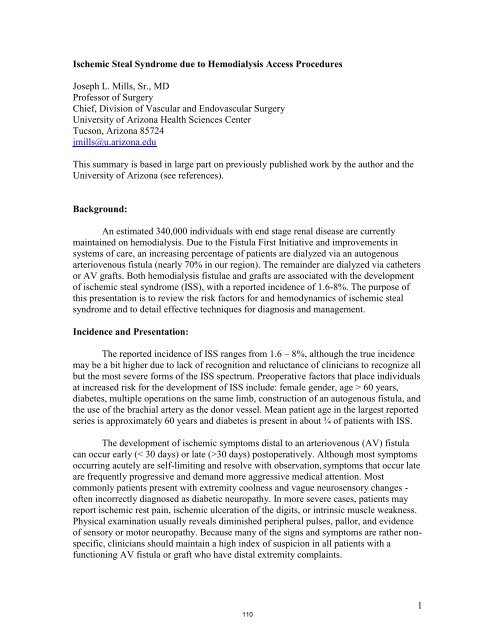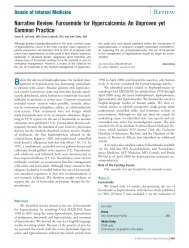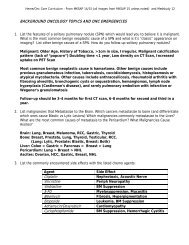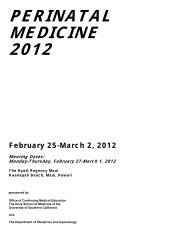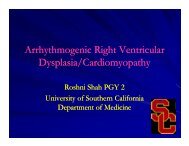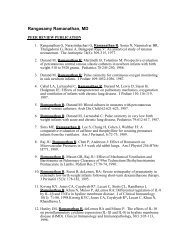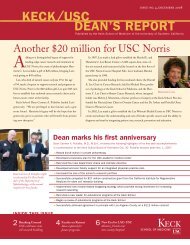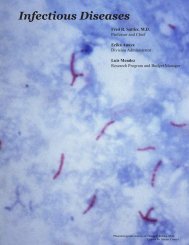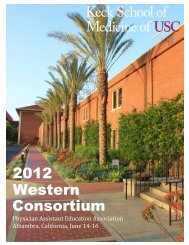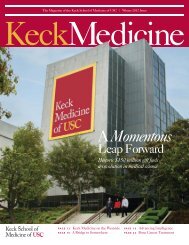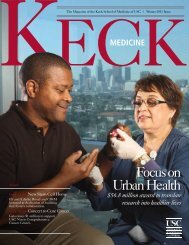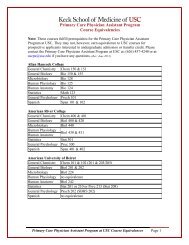Program Book - Keck School of Medicine of USC - University of ...
Program Book - Keck School of Medicine of USC - University of ...
Program Book - Keck School of Medicine of USC - University of ...
- No tags were found...
Create successful ePaper yourself
Turn your PDF publications into a flip-book with our unique Google optimized e-Paper software.
Ischemic Steal Syndrome due to Hemodialysis Access ProceduresJoseph L. Mills, Sr., MDPr<strong>of</strong>essor <strong>of</strong> SurgeryChief, Division <strong>of</strong> Vascular and Endovascular Surgery<strong>University</strong> <strong>of</strong> Arizona Health Sciences CenterTucson, Arizona 85724jmills@u.arizona.eduThis summary is based in large part on previously published work by the author and the<strong>University</strong> <strong>of</strong> Arizona (see references).Background:An estimated 340,000 individuals with end stage renal disease are currentlymaintained on hemodialysis. Due to the Fistula First Initiative and improvements insystems <strong>of</strong> care, an increasing percentage <strong>of</strong> patients are dialyzed via an autogenousarteriovenous fistula (nearly 70% in our region). The remainder are dialyzed via cathetersor AV grafts. Both hemodialysis fistulae and grafts are associated with the development<strong>of</strong> ischemic steal syndrome (ISS), with a reported incidence <strong>of</strong> 1.6-8%. The purpose <strong>of</strong>this presentation is to review the risk factors for and hemodynamics <strong>of</strong> ischemic stealsyndrome and to detail effective techniques for diagnosis and management.Incidence and Presentation:The reported incidence <strong>of</strong> ISS ranges from 1.6 – 8%, although the true incidencemay be a bit higher due to lack <strong>of</strong> recognition and reluctance <strong>of</strong> clinicians to recognize allbut the most severe forms <strong>of</strong> the ISS spectrum. Preoperative factors that place individualsat increased risk for the development <strong>of</strong> ISS include: female gender, age > 60 years,diabetes, multiple operations on the same limb, construction <strong>of</strong> an autogenous fistula, andthe use <strong>of</strong> the brachial artery as the donor vessel. Mean patient age in the largest reportedseries is approximately 60 years and diabetes is present in about ¾ <strong>of</strong> patients with ISS.The development <strong>of</strong> ischemic symptoms distal to an arteriovenous (AV) fistulacan occur early (< 30 days) or late (>30 days) postoperatively. Although most symptomsoccurring acutely are self-limiting and resolve with observation, symptoms that occur lateare frequently progressive and demand more aggressive medical attention. Mostcommonly patients present with extremity coolness and vague neurosensory changes -<strong>of</strong>ten incorrectly diagnosed as diabetic neuropathy. In more severe cases, patients mayreport ischemic rest pain, ischemic ulceration <strong>of</strong> the digits, or intrinsic muscle weakness.Physical examination usually reveals diminished peripheral pulses, pallor, and evidence<strong>of</strong> sensory or motor neuropathy. Because many <strong>of</strong> the signs and symptoms are rather nonspecific,clinicians should maintain a high index <strong>of</strong> suspicion in all patients with afunctioning AV fistula or graft who have distal extremity complaints.1101


